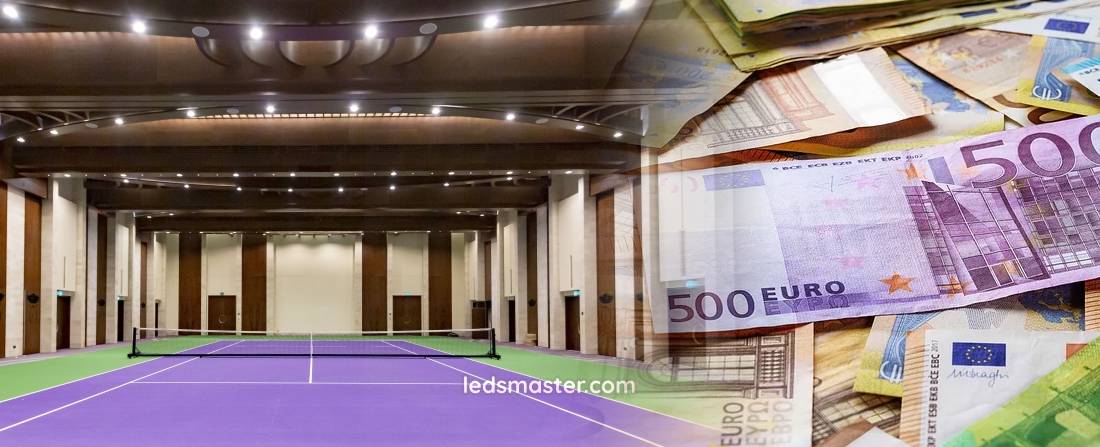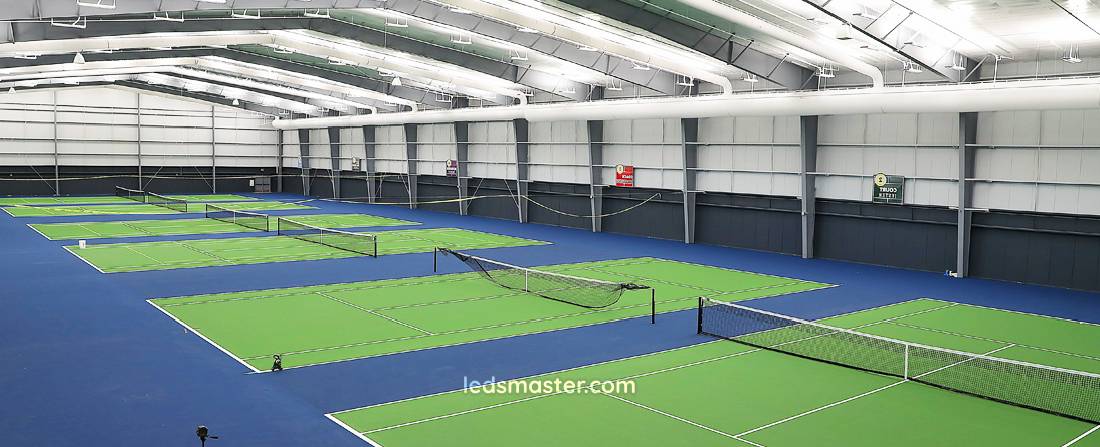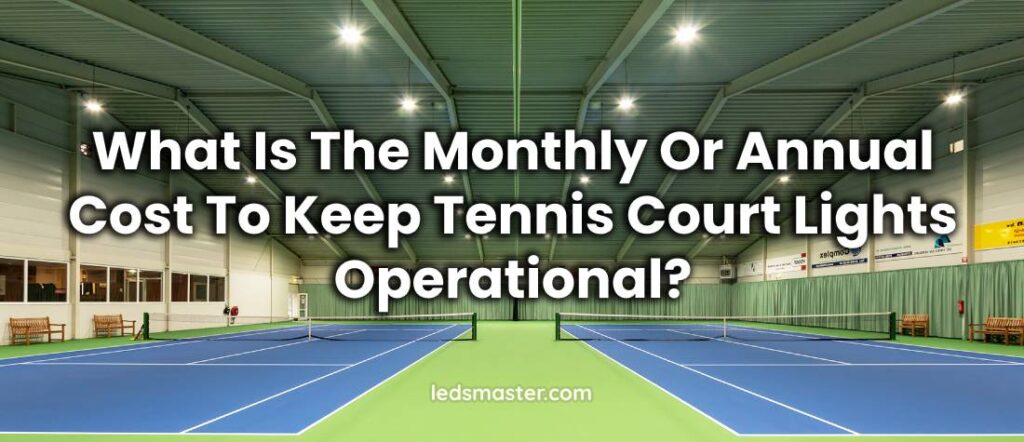Running lights for tennis courts, particularly for night play, involves various costs that can differ based on several factors. These factors influence the total amount spent on lighting, both on a monthly and annual basis. This includes electricity usage, maintenance, and the choice of lighting technology, among other considerations.
Table of Contents
ToggleCalculating Monthly and Annual Costs
To estimate the monthly or annual cost of keeping tennis court lights operational, the total electricity consumption must be calculated. This involves determining the wattage of each light, the number of lights on the court, and the number of hours the lights are used each day.
Monthly Electricity Costs
| Step | Example Calculation |
|---|---|
| Determine Total Wattage | 400 watts per light × 10 lights = 4000 watts (4 kW) |
| Estimate Hours of Use Per Day | 4 hours per evening × 30 days = 120 hours per month |
| Multiply Wattage by Hours of Use | 4 kW × 120 hours = 480 kWh per month |
| Multiply Total Energy Consumption by Rate | 480 kWh × $0.10 per kWh = $48 per month |
To calculate the monthly electricity costs for running tennis court lights, begin by determining the total wattage of all the lights used on the court. For example, if each light uses 400 watts and there are 10 lights, the total wattage is 4000 watts or 4 kilowatts. Next, estimate the number of hours the lights are used each day. If the lights are in use for 4 hours each evening, this totals 120 hours of usage per month. Multiply the total wattage by the number of hours the lights are used to find the energy consumption, which, in this example, is 480 kWh per month. Finally, multiply the total energy consumption by the local electricity rate. If the rate is $0.10 per kWh, the monthly cost would be $48.

Estimating Annual Electricity Costs
To estimate the annual cost of running tennis court lights, the same method used for monthly calculations can be applied, but with a longer time frame. The process begins by determining the monthly electricity cost and then multiplying that amount by 12 to account for the entire year.
For instance, if the monthly cost of lighting the court is $48, you would calculate the annual cost by multiplying this value by 12 months. In this example, the annual cost would be $48 multiplied by 12, which equals $576 per year. This gives a general idea of the total cost to keep the lights on for one year.
Seasonal Variations in Court Usage
This calculation assumes consistent usage of the tennis court for evening play throughout the entire year. In reality, many tennis courts experience fluctuations in usage depending on the season. For example, during the winter months, tennis courts may not be used as frequently for nighttime play due to colder weather or shorter daylight hours. As a result, the actual cost may be lower in the winter, with higher costs during peak seasons when the courts are in more frequent use.
Therefore, while the estimate of $576 per year serves as a general guide, seasonal variations in court usage should be factored in for a more accurate projection of annual lighting costs.
Factors That Influence Lighting Costs
Several aspects influence the cost of keeping tennis court lights operational. The main contributing elements include the type of lighting system installed, the local electricity rates, the duration of court usage, and the maintenance requirements. Each of these elements can vary depending on geographical location, technological choices, and how the facility is managed.
Type of Lighting System
The type of lights used on a tennis court is one of the most influential factors when it comes to operational costs. Traditional lighting options, such as halogen or incandescent lamps, consume a significant amount of energy compared to more modern technologies like LED lights. LED lights have become a popular choice for sports facilities due to their lower energy consumption, longer lifespan, and reduced maintenance needs.
Halogen lights, while still used in some areas, are not as energy-efficient as LEDs and can increase electricity costs considerably. The power required by these older lights contributes to a higher electricity bill, especially if the lights are used for extended periods. Switching to LED lights can significantly reduce these energy costs, even though the initial installation might be more expensive.
Electricity Usage and Rates
Electricity consumption is another major contributor to the cost of running tennis court lights. The wattage of the lights installed directly affects how much energy is consumed. Typically, a tennis court requires several large lights to illuminate the entire playing area adequately. The more lights and higher the wattage, the greater the electricity consumption.
Electricity rates also vary significantly depending on geographical location. In some regions, electricity costs are higher than in others due to local utility pricing structures, taxes, or the source of energy production. For example, areas relying on fossil fuels may have higher electricity rates than those powered by renewable energy sources, such as solar or wind. As a result, tennis court owners must consider both the local cost of electricity and the total number of hours the lights are in use each month to calculate operational costs accurately.

Duration of Court Usage
The length of time the lights are used each month or year is another factor that directly impacts lighting costs. If a tennis court is used frequently for evening play, the lighting costs will naturally be higher. For example, a court that is lit every evening for several hours will have a much larger electricity bill than a court that is only used occasionally after dark.
The number of tennis courts in a facility also affects overall costs. Larger facilities with multiple courts will incur higher lighting costs, particularly if the courts are in constant use. On the other hand, if only one or two courts are in use at night, the cost of lighting can be spread across fewer players, making it more manageable.
Maintenance and Repairs
In addition to electricity costs, there are ongoing maintenance and repair costs associated with tennis court lighting. Regular maintenance is required to ensure that the lighting system functions effectively. This includes cleaning the light fixtures, checking for any electrical issues, and replacing bulbs or components as needed. Over time, the cost of maintaining lighting fixtures can add up, particularly for older systems that may require more frequent repairs.
LED lights, although more expensive to install, tend to require less maintenance than older lighting technologies. Their longer lifespan means they don’t need to be replaced as often, reducing the frequency of repairs and replacements. This can result in lower maintenance costs in the long term, despite the higher upfront investment.
Lighting Design and Placement
The design and placement of the lighting system can also influence how efficiently the lights operate. Proper placement of lights ensures that they illuminate the court evenly, which can reduce the need for excess lighting and lower electricity consumption. Poorly placed lights can create dark spots on the court, prompting the use of additional lights to achieve adequate brightness.
Designing an efficient lighting layout that minimizes wasted energy can help reduce overall costs. For example, modern lighting systems with adjustable fixtures allow operators to focus light where it is needed most, rather than illuminating unnecessary areas. Investing in quality lighting design and placement can optimize energy use and reduce operational costs.
Technology and Energy Efficiency Considerations
Growing Demand for Energy-Efficient Solutions
As the demand for energy-efficient solutions continues to rise, many tennis facilities are increasingly turning to solar-powered lighting systems as a way to reduce their reliance on grid electricity. Solar-powered lights harness energy directly from the sun, which is stored in batteries and used to power the lights at night. This renewable energy source not only helps reduce the environmental impact of traditional lighting but also lowers operational costs over time, making solar lights a more sustainable and cost-effective alternative.
Initial Investment and Long-Term Savings
Although the initial installation of solar-powered lighting can be more expensive than traditional systems, particularly when factoring in the cost of solar panels, batteries, and other required components, the long-term financial benefits are significant. Once installed, solar-powered lights require no ongoing electricity purchases, as they rely on the sun’s energy. As a result, facilities experience a considerable reduction in their monthly energy bills. Over the life of the system, the savings from lower electricity costs can more than offset the higher upfront installation costs.
Durability and Minimal Maintenance
Additionally, solar lights generally have a long lifespan, with some systems lasting up to 25 years or more, which further enhances their cost-effectiveness over time. Furthermore, solar-powered lighting requires minimal maintenance. The system components, such as solar panels and LED fixtures, are durable and can withstand weather conditions, making them a reliable and low-maintenance solution for tennis facilities looking to reduce long-term costs.
Smart Lighting Technology and Automation
In addition to solar lighting, advancements in smart lighting technology are further revolutionizing how tennis courts are illuminated. Smart lighting systems are designed to optimize energy consumption by adjusting the lighting based on real-time conditions. For example, motion sensors or occupancy detectors are installed to detect when players are present on the court. When no one is using the court, the lights can automatically dim or turn off completely, ensuring that energy is only used when necessary.
Reducing Energy Waste with Smart Technology
This automation reduces wasteful energy consumption, which is especially useful for tennis courts that may not be in use for extended periods. By integrating smart lighting systems, tennis facilities can not only reduce their electricity costs but also contribute to sustainability efforts by minimizing energy waste.
Conclusion
The ongoing cost of running tennis court lights is influenced by various factors, including the type of lighting system used, local electricity rates, the duration of court usage, and maintenance needs. While the electricity bill is often the largest portion of the cost, efficient lighting systems, such as LEDs or solar-powered options, can help reduce these expenses. Proper design, placement, and maintenance of the lighting system are also crucial for managing costs effectively.
By understanding the factors that affect lighting costs, tennis court operators can make informed decisions about the best lighting options for their needs, ensuring that the courts remain well-lit for evening play while keeping operational expenses within budget.

